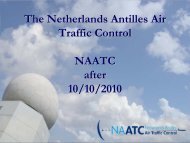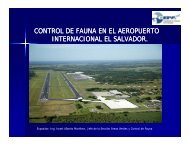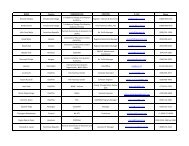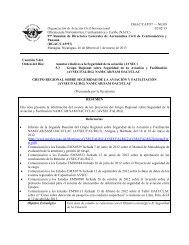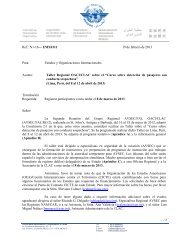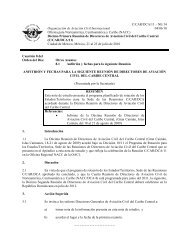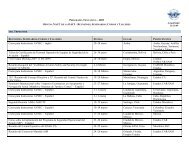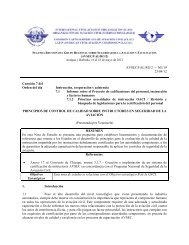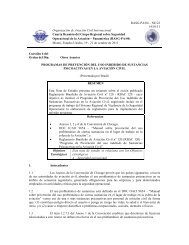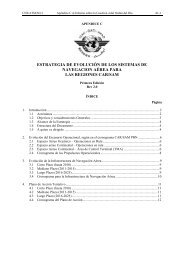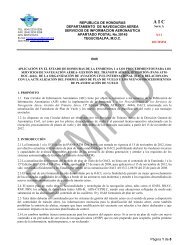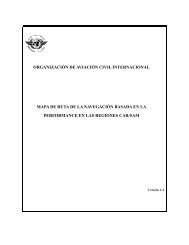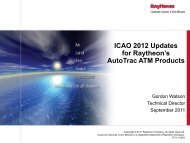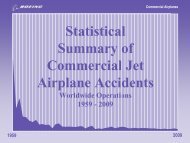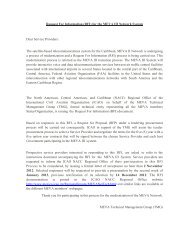E/CAR/WG/33 — WP/18 International Civil Aviation ... - NACC - ICAO
E/CAR/WG/33 — WP/18 International Civil Aviation ... - NACC - ICAO
E/CAR/WG/33 — WP/18 International Civil Aviation ... - NACC - ICAO
Create successful ePaper yourself
Turn your PDF publications into a flip-book with our unique Google optimized e-Paper software.
E/<strong>CAR</strong>/<strong>WG</strong>/<strong>33</strong> <strong>—</strong> <strong>WP</strong>/<strong>18</strong><br />
<strong>International</strong> <strong>Civil</strong> <strong>Aviation</strong> Organization 28/05/12<br />
North American, Central American and Caribbean Office (<strong>NACC</strong>)<br />
Thirty-Third Eastern Caribbean Working Group Meeting<br />
(E/<strong>CAR</strong>/<strong>WG</strong>/<strong>33</strong>)<br />
Christ Church, Barbados, 4 to 8 June 2012<br />
Agenda Item 3: Air Navigation Matters<br />
3.3 Specific Developments in Air Navigation<br />
� CNS<br />
AIDC IMPLEMENTATION IN THE <strong>CAR</strong> REGION<br />
(Presented by the Secretariat)<br />
SUMMARY<br />
This paper presents the current progress and operational benefits of the<br />
implementation of ATS Inter-facility Data Communications (AIDC) in the Central<br />
Caribbean and Central American Regions, for the E/<strong>CAR</strong> Region evaluation and<br />
similar implementation<br />
REFERENCES<br />
� Report of the 13 th GREPECAS Meeting Report, (Santiago, Chile, 14 – <strong>18</strong><br />
November 2005)<br />
� Report of the 15 th GREPECAS Meeting Report, (Rio de Janeiro, Brazil, 13 –<br />
17 October 2008)<br />
� Report of Seventh Central American Air Navigation Experts Working Group -<br />
(CA/ANE/<strong>WG</strong>/7), Ninth Central Caribbean Working Group (C/<strong>CAR</strong>/<strong>WG</strong>/9)<br />
(<strong>ICAO</strong> <strong>NACC</strong> Regional Office, Mexico City, Mexico, 5 to 9 March 2012<br />
� NAM/<strong>CAR</strong> Regional Air Navigation Implementation Plan (NAM/<strong>CAR</strong><br />
RPBANIP) ver 2.0<br />
<strong>ICAO</strong> strategic<br />
objectives:<br />
1. Introduction<br />
This paper is related to Strategic Objective A and C<br />
1.1 Automated data exchange between ATC systems support timely dissemination of<br />
relevant flight data, particularly in regard to coordination and transfer of flights between ATS units. ATS<br />
interfacility Data Communication (AIDC) application exchanges information between ATS units in<br />
support of critical ATC functions, including notification of flights approaching a flight information region<br />
(FIR) boundary, coordination of boundary-crossing conditions, and transfer of control.<br />
1.2 Under GREPECAS Conclusion 13/79 – Development of national plans to prioritize the<br />
AMHS and AIDC implementation and obtain the benefits of ATM System Automation, States and<br />
Territories were urged to develop their national plans on these implementations.
E/<strong>CAR</strong>/<strong>WG</strong>/<strong>33</strong> <strong>—</strong> <strong>WP</strong>/<strong>18</strong><br />
<strong>—</strong> 2 <strong>—</strong><br />
1.3 Under GREPECAS Conclusion 15/36 Measures to Reduce Operational Errors in the<br />
ATC Coordination loop between Adjacent ACCs, urge <strong>CAR</strong>/SAM States/Territories/<strong>International</strong><br />
Organizations to apply, on an urgent basis among other measures, the programme for the prevention of<br />
errors in the coordination loop between adjacent ACCs in order to reduce LHDs caused by errors in<br />
traffic coordination messages between ATC units to achieve an acceptable target level of safety, which<br />
suggested as part of the solution that <strong>CAR</strong>/SAM States/Territories/<strong>International</strong> Organizations gradually<br />
implement the AIDC for data exchange among ATC units, enhancing the safety of the airspace and the<br />
reduction of category “M” errors. This conclusion also requested <strong>ICAO</strong> to coordinate, provides<br />
assistance, and conduct follow-up on the implementation of these corrective measures.<br />
1.4 The current Regional Planning for AIDC implementation is on <strong>CAR</strong>/SAM Air<br />
Navigation Plan Table CNS 1BB – ATN ground-ground Applications Plan, which is available at <strong>ICAO</strong><br />
<strong>NACC</strong> Regional Webpage: http://mexico.icao.int/fasid/FASIDTableCNS1Bbrev29-08-08.pdf.<br />
2. Discussion<br />
2.1 In line to facilitate the implementation of the AIDC and its benefits, under the <strong>CAR</strong>/SAM<br />
Regional Guidelines for Strategy Operational Integration of the ATM Automated Systems of the<br />
<strong>CAR</strong>/SAM Regions, the gradual implementation of AIDC in line with the automation of ATC Systems is<br />
expected under the stage III of the evolution of ATM Automation:<br />
2.2 The NAM/<strong>CAR</strong>/SAM regions adopted an Interface control document (ICD) based on the<br />
experience gained by the NAM States. This document is available at:<br />
http://www.mexico.icao.int/CNS.html
<strong>—</strong> 3 <strong>—</strong><br />
E/<strong>CAR</strong>/<strong>WG</strong>/<strong>33</strong> <strong>—</strong> <strong>WP</strong>/<strong>18</strong><br />
2.3 Similarly the NAM/<strong>CAR</strong> Regional Performance-Based Air Navigation Implementation<br />
Plan (NAM<strong>CAR</strong> RPBANIP) includes in its Regional Performance Objective (RPO) 3. Improve ATM<br />
Situational Awareness, the planning to implement applications such as: ADS, CPDLC, AIDC, as required<br />
and in the time frame of 2008 to 2014. Also under its RPO 9 Optimization and Modernization of<br />
Communication Infrastructure, as part of the applications for the Aeronautical Telecommunication<br />
Network (ATN), the evaluation of the current telecommunication network infrastructure is in place as<br />
reflected in the E/<strong>CAR</strong> CNS Committee action Plan: ACT PLAN COM: 11.Technical evaluation of<br />
communications and interfaces for AIDC implementation over the AFTN.<br />
2.4 As a result of the discussions of the Workshop on ATM Situational Awareness<br />
Improvements for the NAM/<strong>CAR</strong> Regions, held in the <strong>ICAO</strong> <strong>NACC</strong> Regional Office in Mexico City,<br />
Mexico from 8 to 10 July 2010, the workshop developed the following recommendations, which are to be<br />
addressed by <strong>CAR</strong> Region States/Territories/<strong>International</strong> Organizations and <strong>ICAO</strong>, as appropriate:<br />
a) consider the availability and capacity of the existing regional telecommunication<br />
networks in the <strong>CAR</strong> region for the implementation of situational awareness<br />
improvements, mainly for the purpose of sharing surveillance data and for the<br />
provision of AIDC;<br />
b) based on the operational requirements, States/Territories/<strong>International</strong> Organizations,<br />
should review the AIDC messages defined in the PANS-ATM and the ICD<br />
document, complete and finalize the OLDI/AIDC implementation activities,<br />
including carrying out an interface and technical interconnection analysis for the<br />
identified AIDC/OLDI implementation between ATS Units;<br />
2.5 In the Seventh Central American Air Navigation Experts Working Group (C/<strong>CAR</strong>/<strong>WG</strong>) -<br />
Ninth Central Caribbean Working Group (CA/ANE/<strong>WG</strong>) Meeting held in the <strong>ICAO</strong> <strong>NACC</strong> Regional<br />
Office in Mexico City, Mexico from 5 to 9 March 2012, the meeting was informed of the experience and<br />
benefits with the implementation of Current Flight Plan (CPL) messages between COCESNA and<br />
Mexico, the automatic exchange of flight plans (CPL) between the ATC Control Center in Miami and the<br />
ACC in La Havana, exchange between the ACC in La Havana, Cuba and the ACC in Merida, Mexico and<br />
the experience in AIDC between Canada, United States and Mexico, emphasizing the testing process for<br />
AIDC between Cuba and United States.<br />
2.6 The C/<strong>CAR</strong>/<strong>WG</strong>/9 Meeting recognized the benefits and improvements achieved with the<br />
use of AIDC as means for the exchange of notification, coordination, transfer and related data between<br />
automated ATS systems. The AIDC infrastructure significantly has reduced the need for verbal<br />
coordination between Air Traffic Service Units and that AIDC can provide the means by which<br />
automated data exchange can be harmonized between ATS Units providing air traffic service in the<br />
Caribbean region. The automation gains of AIDC implementation had provided significant safety and<br />
efficiency benefits as:<br />
a) Reduced workload for controllers<br />
b) Reduction of readback/hearback errors during coordination<br />
c) Reduced “controller to controller” coordination errors; and language barrier issues<br />
d) Increased in support for performance based navigation initiatives and emerging<br />
technologies with automation
E/<strong>CAR</strong>/<strong>WG</strong>/<strong>33</strong> <strong>—</strong> <strong>WP</strong>/<strong>18</strong><br />
<strong>—</strong> 4 <strong>—</strong><br />
2.7 Also, the C/<strong>CAR</strong>/<strong>WG</strong> identified that the AIDC implementation (using CPL messages)<br />
requires considerable effort and planning involved during development, testing, and implementation of<br />
the automation interface. These tasks included airspace and system parameter adaptation, ATC procedure<br />
coordination, Letter of Agreement tailoring, communications interoperability and protocol testing and<br />
troubleshooting, and controller training. Both non-operational and operational testing was extensively<br />
conducted. The telecommunication infrastructure for automated data exchange interfaces consists of<br />
NADIN, MEVA II, and other interconnections which support the automated data exchange as well as<br />
AFTN messaging.<br />
2.7 The C/<strong>CAR</strong>/<strong>WG</strong> recommended that as ATS providers develop their automation systems,<br />
consideration should be given to meeting the capabilities identified within an interface specification such<br />
as the <strong>CAR</strong>/SAM ICD. United States described the implementation of the AIDC with Canada and<br />
Mexico, Class I messages (CPL-LAM)/ Class II messages and the personalization of the messages to<br />
satisfy the operational requirements included in their NAM ICD.<br />
2.8 Other <strong>CAR</strong> States also expressed their interest in implementing the AIDC initially with<br />
the CPL – LAM messages like Curaçao, Dominican Republic and Jamaica. Similarly in Central America<br />
the AIDC is being implemented through the OLDI functionality.<br />
2.9 Considering the benefits presented with the implementation of CPL-LAM messages and<br />
due to the high level of automation in the <strong>CAR</strong> Region ATC Systems, the C/<strong>CAR</strong>/<strong>WG</strong> and the<br />
CA/ANE/<strong>WG</strong> agreed in the following Conclusion:<br />
CONCLUSION 1 ACTION PLAN FOR AIDC IMPLEMENTATION; USING CPL -<br />
LAM MESSAGES<br />
That, considering the importance and benefits of AIDC implementation, States/<br />
Territories of the Central Caribbean and Central America:<br />
a) inform the <strong>ICAO</strong> <strong>NACC</strong> Regional Office about the capacity of their ATC Systems to<br />
process CPL - LAM messages no later than 21 September 2012;<br />
b) review the NAM ICD and <strong>CAR</strong>/SAM ICD as a basis to implement AIDC, recommending<br />
changes to the <strong>CAR</strong>/SAM ICD for its update no later than 26 October 2012;<br />
c) prepare together with <strong>ICAO</strong> an action plan to harmonize the AIDC implementation for<br />
the use of CPL – LAM messages; and<br />
d) present this Action plan to the next Working Group meetings for its implementation.<br />
2.10 With the New Flight plan Format upgrades, several systems are being updates by all<br />
States and many of them have the AIDC processing capabilities like PIARCO ATC System and other.<br />
3. Suggested action<br />
3.1 The Meeting is invited to:<br />
a) take note of the information contained in this paper;<br />
b) revise the progress and benefits being obtained by the Central Caribbean and Central<br />
American States with the AIDC implementation and their conclusion 1 (paragraph<br />
2.9);<br />
c) based on the current status and needs of the E/<strong>CAR</strong> Region, adopt a similar<br />
conclusion to paragraph 2.9; and<br />
d) analyse other considerations that it may deem necessary in relation to this matter.<br />
<strong>—</strong> END <strong>—</strong>



